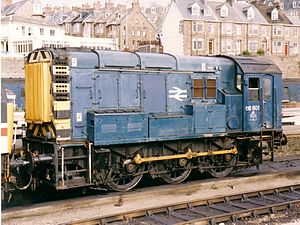
Back British Rail řada 08 Czech BR-Klasse 08 German イギリス国鉄08形ディーゼル機関車 Japanese Class 08 Dutch British Rail Class 08 SIMPLE
| British Rail Class 08 | |||||||||||||||||||||||||||||||||||||||||||||||||
|---|---|---|---|---|---|---|---|---|---|---|---|---|---|---|---|---|---|---|---|---|---|---|---|---|---|---|---|---|---|---|---|---|---|---|---|---|---|---|---|---|---|---|---|---|---|---|---|---|---|
 08 801 at Penzance station in 1990 | |||||||||||||||||||||||||||||||||||||||||||||||||
| |||||||||||||||||||||||||||||||||||||||||||||||||
| |||||||||||||||||||||||||||||||||||||||||||||||||
| |||||||||||||||||||||||||||||||||||||||||||||||||
| |||||||||||||||||||||||||||||||||||||||||||||||||
The British Rail Class 08 is a class of diesel–electric shunting locomotives built by British Railways (BR). As the standard BR general-purpose diesel shunter, the class became a familiar sight at major stations and freight yards. Since their introduction in 1952, however, the nature of rail traffic in Britain has changed considerably. Freight trains are now mostly fixed rakes of wagons, and passenger trains are mostly multiple units or have driving van trailers, neither requiring the attention of a shunting locomotive. Consequently, a large proportion of the class has been withdrawn from mainline use and stored, scrapped, exported or sold to industrial or heritage railways.
As of 2020, around 100 locomotives remained working on industrial sidings and on the main British railway network. On heritage railways, they have become particularly common, appearing on many of the preserved standard-gauge lines in Britain, with over 80 preserved, including the first one built.[3]
- ^ a b c d e f g "Preface, General Data". Diesel Engine Instruction and Maintenance Manual. Strand, London: English Electric. p. Instruction 701/9/1/1, Instruction 703/10/2/1–703/10/2/2, Instruction 704/1/1/1–704/1/1/2.
- ^ https://sdjr.co.uk/locomotives-stock/d4095
- ^ Fleet status (subsection Class 01-14) wnxx.net Archived 20 October 2007 at the Wayback Machine